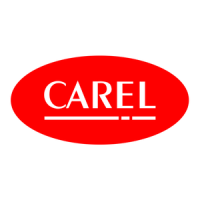28
ENG
ir33 universale +030220801 - rel. 2.1 - 21.06.2011
Key
St1 Set point 1
P1/P2 “Reverse”/”direct” di erential
P3 Dead zone di erential
OUT1/2/3/4 Output 1/2/3/4
B1 Probe 1
When the controller only has 1 output, it works in “reverse” mode with
dead zone.
PWM mode should not be used with compressors or other actuators
whose reliability may be a ected by starting/stopping too frequently.
For relay outputs, parameter c12 should not be set too low, so as to not
compromise the life of the component..
5.3.5 Mode 5: Alarm c0=5
In mode 5, one or more outputs are activated to signal a probe
disconnected or short-circuited alarm or a high or low temperature alarm.
Models V and W only have one alarm relay, while model Z has two: relay
3 is activated for general alarms and for the low temperature alarm, relays
4 is activated for general alarms and for the high temperature alarm. The
activation of the alarm relay is cumulative to the other signals in the other
operating modes, that is, alarm code on the display and audible signal.
For models W & Z, the relays not used to signal the alarms are used for
control, as for mode 3 and shown the following diagrams. This operation
mode is not suitable for the models B and E.
The parameters corresponding to probe 2 become active with
independent operation (c19=7).
Par. Description Def Min Max UOM
P25 Low temp. alarm threshold probe 1
P29= 0, P25= 0: threshold disabled
P29= 1, P25= -50: threshold disabled
-50
(-58)
-50
(-58)
P26 °C (°F)
P26 High temp. alarm threshold probe 1
P29= 0, P26= 0: threshold disabled
P29= 1, P26= 150: threshold disabled
150
(302)
P25 150
(302)
°C (°F)
P27 Alarm di erential on probe 1 2 (3,6) 0(0) 50(90) °C (°F)
P25 Low alarm threshold on probe 1
P29= 0, P25= 0: threshold disabled
P29= 1, P25= -199: threshold disabled
-50
(-58)
-199
(-199)
P26 °C (°F)
P26 High alarm threshold on probe 1
P29= 0, P26= 0: threshold disabled
P29= 1, P26= 800: threshold disabled
150
(302)
P25 800
(800)
°C (°F)
P27 Alarm di erential on probe 1 2
(3,6)
0(0) 99,9
(179)
°C (°F)
P28 Alarm delay time on probe 1(*) 120 0 250 min(s)
P29 Type of alarm threshold
0= relative;
1= absolute.
101-
P30 Low temp. alarm threshold probe 2
if P34= 0, P30= 0: threshold disabled
if P34= 1, P30= -50: threshold disabled
-50
(-58)
-50
(-58)
P31 °C (°F)
P31 High temp. alarm threshold probe 2
if P34= 0, P31= 0: threshold disabled
if P34= 1, P31= 150: threshold disabled
150
(302)
P30 150
(302)
°C (°F)
P32 Alarm di erential on probe 2 2 (3,6) 0(0) 50(90) °C (°F)
P30 Low alarm threshold on probe 2
if P34= 0, P30= 0: threshold disabled
if P34= 1, P30= -199: threshold disabled
-50
(-58)
-199
(-199)
P31 °C (°F)
P31 High alarm threshold on probe 2
if P34= 0, P31= 0: threshold disabled
if P34= 1, P31= 800: threshold disabled
150
(302)
P30 800
(800)
°C (°F)
P32 Alarm di erential on probe 2 2
(3,6)
0(0) 99,9
(179)
°C (°F)
P33 Alarm delay time on probe 2(*) 120 0 250 min(s)
P34 Type of alarm threshold on probe 2
0= relative; 1= absolute.
101-
Tab. 5.e
(*) In the event of alarms from digital input, the unit of measure is seconds (s).
5.3.3 Mode 3: Dead zone c0=3
The aim of this control mode is to bring the measured value within an
interval around the set point (St1), called the dead zone. The extent of the
dead zone depends on the value of parameter P3. Inside the dead zone, the
controller does not activate any outputs, while outside it works in “direct”
mode when the temperature is increasing and in “reverse” mode when it
is decreasing. According to the model used, there may be one or more
outputs in “direct” and “reverse” modes. These are activated or deactivated
one at a time, as already described for modes 1 & 2, according to the value
measured and the settings of St1, P1 for “reverse” control and P2 for “direct”
control.
ON
OUT1
Mod. V
OFF
St1
B1P1 P3
OUT1 OUT2
Mod. W
St1
B1P1 P3 P3
P2
OUT1OUT2OUT4OUT3
Mod. Z
St1
B1
P1 P3 P3 P2
Fig. 5.e
Key
St1 Set point 1
P1/P2 “Reverse”/”direct” di erential
P3 Dead zone di erential
OUT1/2/3/4 Output 1/2/3/4
B1 Probe 1
When the controller only has 1 output, it works in “reverse” mode with
dead zone.
5.3.4 Mode 4: PWM c0=4
The control logic in PWM mode uses the dead zone, with the outputs
activated based on pulse width modulation (PWM). The output is
activated in a period equal to the value of parameter c12 for a variable
time, calculated as a percentage; the ON time is proportional to the value
measured by B1 inside the di erential (P1 for “reverse” control and P2 for
“direct” control). For small deviations, the output will be activated for a
short time. When exceeding the di erential, the output will be always
on (100% ON). PWM operation thus allows “proportional” control of
actuators with typically ON/OFF operation (e.g. electric heaters), so as to
improve temperature control. PWM operation can also be used to gave
a modulating 0 to 10 Vdc or 4 to 20 mA control signal on IR33 (DN33)
Universal models A, D with outputs for controlling solid state relays (SSR).
In this case, the accessory code CONV0/10A0 needs to be connected to
convert the signal. In PWM operation, the “direct”/”reverse” icon ashes.
100%
OUT1
Mod. V
0%
St1
B1P1 P3
100%
OUT1
Mod. W / B
0%
St1
B1P1 P3
OUT2
P2P3
100%
OUT1OUT2
Mod. Z / A / E
0%
St1
B1P1/2
P1/2 P2/2P3
OUT3 OUT4
P2/2P3
Fig. 5.f

